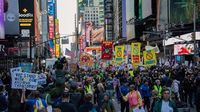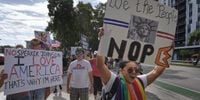On October 18, 2025, a remarkable scene unfolded across the United States: from the icy reaches of International Falls, Minnesota, to the bustling avenues of New York City and the sun-baked streets of San Diego, millions of Americans joined together for the second nationwide No Kings protest of the year. According to organizers and reports from outlets including Axios and Fox News Digital, nearly 7 million people participated in around 2,700 events, making it one of the largest single-day protests in American history.
The No Kings movement, with its roots in defending democratic values and resisting authoritarianism, drew participants from every state and a broad spectrum of the political landscape. In Minneapolis, the crowd heard from U.S. Senator Tina Smith and Attorney General Keith Ellison, alongside local immigrant rights and civil liberties groups. As reported by Commentary MinnPost, these rallies were coordinated by groups like Indivisible, emphasizing nonviolence and inclusivity. The result? Streets packed with people of all backgrounds—anarchists, moderates, and even “chardonnay-sipping liberals”—marching shoulder to shoulder.
Protesters wielded signs with messages such as “We the People,” “The Constitution is not optional,” “Democracy not monarchy,” and “No kings since 1776,” as documented by Politico. In New York City, the Statue of Liberty was a recurring costume, while in Florida, demonstrators brandished signs warning that the “Florida heat would melt ICE.” Texas marchers called on Gov. Abbott and Sen. Cruz to push back against what they described as presidential overreach.
Despite the massive turnout, the protests were overwhelmingly peaceful. Major police departments—from New York and Chicago to Austin, San Diego, and Washington, D.C.—reported zero arrests related to protest activity. “We had more than 100,000 people across all five boroughs peacefully exercising their First Amendment rights and the NYPD made zero protest-related arrests,” the New York City Police Department posted on X. San Diego’s department echoed the sentiment: “Thanks to the more than 25,000 people who came out and exercised their first amendment right peacefully and responsibly. Once again, no one was arrested.” Chicago police confirmed to Axios that they too made no protest-related arrests, and D.C.’s Metropolitan Police reported similar results.
This peacefulness stands in stark contrast to previous protests during President Donald Trump’s current term, where demonstrations—such as those at Trump Tower in June and March 2025—resulted in dozens of arrests. The difference was not lost on participants, who saw their nonviolent approach as a powerful rebuke to claims that mass protest inevitably leads to chaos.
Yet, not everyone viewed the demonstrations so positively. Republican leaders, including House Speaker Mike Johnson, condemned the No Kings events as “hate America” rallies, while the Republican National Committee described participants as “rage-fueled antagonists inciting political violence.” Ahead of the protests, some GOP lawmakers even warned that the administration might have to deploy the National Guard to protest sites. President Trump himself responded after the rallies by posting an AI-generated video depicting himself wearing a crown, piloting a jet labeled “KING TRUMP,” and dumping brown sludge on protesters—a move widely interpreted as an attempt to mock and delegitimize the movement.
Despite these criticisms, many protesters insisted that their actions were quintessentially American. As Rep. Pat Ryan told Politico Playbook, “There’s literally nothing more patriotic and more American than exercising your First Amendment rights when you disagree with the direction of your country.” In his district, he planned to read aloud the Declaration of Independence, calling it “the original ‘No Kings’ document.”
The protests were not without controversy. As Fox News Digital reported, several viral social media clips from Chicago overshadowed the peaceful tone of the day. One video showed a woman, identified by users as a K-8 STEM teacher, appearing to mock the assassination of conservative activist Charlie Kirk. Chicago Public Schools acknowledged awareness of the incident and reaffirmed their commitment to a safe and inclusive environment, stating that they follow consistent disciplinary processes for employee misconduct. Other videos from the city depicted a man calling for violence against ICE agents and another encouraging a child to strike a Donald Trump piñata. The Chicago Police Department did not comment on these incidents, but the Department of Homeland Security confirmed that at least one individual from the videos was under investigation. Such moments, while isolated, fueled criticism from conservative commentators who argued that they revealed a deeper hostility within some corners of the protest movement.
Still, these incidents were the exception, not the rule. Organizers and most attendees emphasized the overwhelmingly peaceful and joyful nature of the protests. Many embraced humor and costuming as a way to broaden the appeal of the movement and defuse tension. As recounted by a MinnPost columnist, participants donned inflatable unicorn costumes and danced through the streets, drawing inspiration from international protest icons like Chile’s “Tía Pikachu.” The message was clear: unity, joy, and a sense of community could be powerful tools against fear and repression.
Underlying the spectacle was a deep concern about the direction of the country. Since returning to office in January 2025, President Trump’s administration had pursued a far-right agenda—cracking down on immigration, slashing healthcare and climate change funds, and rolling back support for domestic violence and reproductive health programs, particularly those impacting women. According to polls cited by Politico, Trump’s approval rating had dropped to 44 percent, with a significant gender gap: 44 percent approval among men, but just 34 percent among women. On immigration, the gap was even wider, with 52 percent of men approving of Trump’s policies compared to 38 percent of women.
Federal agencies, meanwhile, had ramped up enforcement in liberal cities, detaining more than 170 American citizens in recent months. The Twin Cities, organizers warned, remained a target for future immigration actions and potential federal overreach. As a result, activists called on participants to remain vigilant and ready to mobilize again—no small ask, as one columnist noted, but a necessary step to defend constitutional rights.
Looking ahead, the No Kings movement shows no sign of slowing down. Organizers have already scheduled the next mass protest for March 29, 2026, and planned a nationwide call to discuss strategy and next steps. For many, the October 18 demonstrations were not just a protest, but a joyful affirmation of democracy, solidarity, and the enduring power of the American people to stand up and be counted—even, or especially, in the face of adversity.






